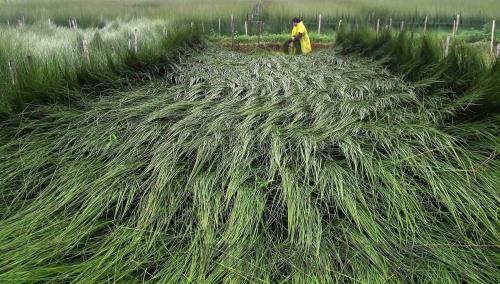|
 |
|
GOLD RUSH: A farmer harvests rush in the rain in Yinzhou District of Ningbo, east China's Zhejiang Province. Woven rush mats have become a major source of income for local farmers (HU XUEJUN) |
More Flexible Yuan
China's State Administration of Foreign Exchange (SAFE) announced on July 2 that it will allow banks to set their own exchange rates for the yuan against the U.S. dollar with clients, a further step in the liberalization of yuan exchange rates.
Banks can set their yuan/dollar exchange rate in their over-the-counter deals with clients on the basis of market demand, the SAFE said in a statement.
The regulation entered into effect on July 2. Before the new move, the spreads in banks' yuan/dollar buying and selling prices were subject to regulatory controls. The People's Bank of China, the central bank, widened the spreads to 3 percent from the previous 2 percent in March.
New GDP Calculation
The National Bureau of Statistics (NBS) plans to include research and development spending as it revises its methodology for calculating GDP.
NBS has completed a draft plan and will submit it to the State Council for approval before the end of the year.
The change will lead to a rise in the aggregate economy and economic growth rate.
Some regions, such as Beijing, have heavier research input. The revision will increase the gap of total GDP between eastern and western regions.
China spent 1.19 trillion yuan ($191 billion) on research and development in 2013, an increase of 15.6 percent over the previous year. Experts say about three quarters of the research input can be transferred to GDP, and it will contribute about 1 trillion yuan ($160 billion) if counted, or a lift of 1.56 percent.
Prior to the change, NBS had adjusted its GDP accounting methodologies three times. The United States implemented a similar plan last year when it added research input to the calculation of its economic growth.
New Pilot Zone
China has officially approved a new zone in the northeastern coastal city of Dalian to steer local development and boost cooperation with Northeast Asian countries, the local government said on July 2.
The Dalian Jinpu New Area aims to help develop a coastal economic belt in Liaoning Province and enhance economic growth in the country's northeast.
The New Area, approved by the State Council, will be a pilot zone for innovation, and is expected to help Dalian become an international shipping center and a global logistics hub.
It covers about 2,299 square km and boasts numerous geographical and economic advantages.
Rejecting GM Corn
China's quarantine watchdog has returned 1.25 million tons of corn shipments from the United States in recent months over genetic modification concerns, an official said on June 30.
Since October, Chinese authorities have been finding U.S. corn shipments tainted with genetically modified (GM) strain MIR162, said Lu Chunming, an official with the General Administration of Quality Supervision, Inspection and Quarantine.
MIR162, a kind of insect-resistant transgenic corn, is not approved by China's agriculture ministry.
The first batch of MIR162-tainted corn was found in Shenzhen, south China's Guangdong Province, and more have been detected at other ports.
The country rejected 601,000 tons of unapproved GM corn imports in 2013, according to the administration. | 